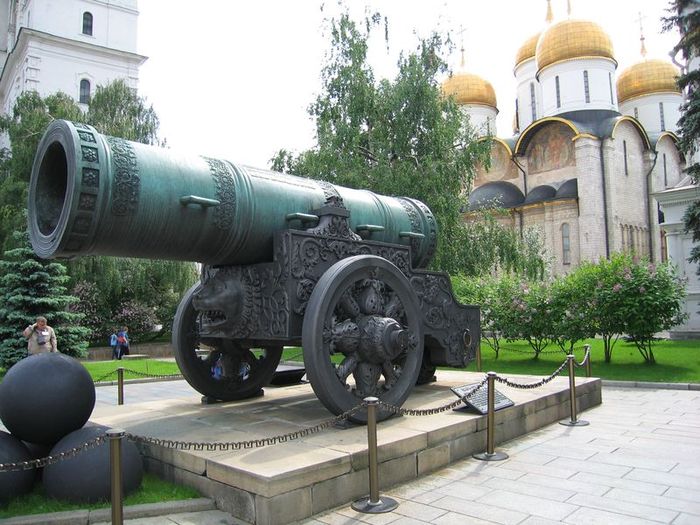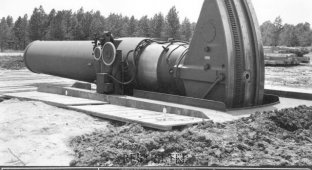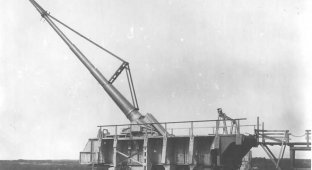As you know, the Tsar Cannon is a medieval artillery piece and a monument to Russian artillery, cast in bronze in 1586 by Russian master Andrei Chokhov at the Cannon Yard. Today we will try to find out whether it is possible to shoot from it or is it still a prop.

The author writes: There are many misconceptions about her among the people. For example: “Russia had the most powerful and advanced production and technological base for the production of cast iron in the world, the monuments of which are these unique artifacts (this is about the Tsar Bell and the Tsar Cannon - author)... has long been proven, and there is documentary evidence that the Tsar Cannon actually fired.”

It’s clear from the bell. They are made exclusively from bronze, and not just any bronze, but a special composition. Well, guns, of course, are different. For this purpose, in difficult times, our wonderful people even used birch burl. They took a dense thick birch piece, made a hole in it, bound it with iron strips, burned a small hole in the breech for the fuse, and now the cannon was ready. In the 17th…19th centuries, they were mainly cast from cast iron. But the Tsar Cannon is still bronze.
An important note about documentary evidence that the cannon fired. Indeed, people are circulating information that certain experts have precisely established... discovered... etc. This rumor was started by journalists. Who and what actually established will be discussed in detail below. Let us also consider the question of another misconception that haunts the minds of scientists. Many of them believe that the Tsar Cannon is a huge shotgun. A very convenient opinion that allows historians to explain many of the mysteries associated with it. In fact, this is not the case, as will be convincingly shown.
There is another persistent misconception that makes one doubt the rationality of human nature. They say that the Tsar Cannon was made to frighten foreigners, especially the ambassadors of the Crimean Tatars. The absurdity of this statement will also become obvious as you read the article.
What arguments can be made:
Firstly, the cast iron cannonballs are striking, which in the 19th century became the source of those same conversations about the decorative purpose of the cannon. In the 16th century they used stone cores, and they were 2.5 times lighter than the cast iron ones. It can be said with absolute certainty that the walls of the cannon would not have withstood the pressure of the powder gases when fired with such a cannonball. Of course, this was understood when they were cast at the Byrd plant.
Secondly, a fake carriage, cast there. You can't shoot from it. When firing a standard 800-kilogram stone cannonball from a 40-ton Tsar Cannon, even with a low initial speed of 100 meters per second, the following will happen:
expanding powder gases, creating increased pressure, will, as it were, expand the space between the core and the bottom of the gun; the core will begin to move in one direction, and the cannon in the opposite direction, and the speed of their movement will be inversely proportional to the mass (the lighter the body, the faster it will fly).

The mass of the cannon is only 50 times the mass of the cannonball (in a Kalashnikov assault rifle, for example, this ratio is about 400), so when the cannonball flies forward at a speed of 100 meters per second, the cannon will roll back at a speed of about 2 meters per second. This colossus will not stop right away, after all, it’s 40 tons. The rollback energy will be approximately equal to a hard impact of the KAMAZ into an obstacle at a speed of 30 km/h. The Tsar Cannon will be torn off its carriage. Moreover, she simply lies on top of him like a log. All this can only be held by a special sliding carriage with hydraulic dampers (recoil dampers) and reliable mounting of the gun. I assure you, this is still quite an impressive device today, but then this simply did not exist. And all this is not just my opinion: “Currently, the Tsar Cannon is on a decorative cast-iron carriage, and next to it lie decorative cast-iron cannonballs, which were cast in 1834 in St. Petersburg at the Berda iron foundry. It is clear that it is physically impossible to either shoot from this cast-iron carriage or use cast-iron cannonballs - the Tsar Cannon will be smashed to smithereens!” (Alexander Shirokorad “Miracle Weapons of the Russian Empire”). Therefore, the artillery complex that they show us in the Kremlin called the Tsar Cannon is a giant prop.

Today, hypotheses about the use of the Tsar Cannon as a shotgun are persistently discussed. The opinion is very convenient for historians. If it's a shotgun, then you don't need to carry it anywhere. I put it at the loophole and that’s it, wait for the enemy.

Today, hypotheses about the use of the Tsar Cannon as a shotgun are persistently discussed. The opinion is very convenient for historians. If it's a shotgun, then you don't need to carry it anywhere. I put it at the loophole and that’s it, wait for the enemy.
What Andrei Chokhov cast in 1586, that is, the bronze barrel itself, could really fire. It would just look completely different from what many people think. The fact is that, by its design, the Tsar Cannon is not a cannon, but a classic bombard. A cannon is a weapon with a barrel length of 40 calibers and above. The Tsar Cannon has a barrel length of only 4 calibers. But for a bombard this is just normal. They often had an impressive size, and were used for siege, like battering weapons. To destroy a fortress wall, you need a very heavy shell. This is what giant calibers are for.
There was no talk of any gun carriage then. The trunk was simply buried in the ground. The flat end rested on deeply driven piles (Fig. 2). Nearby they dug 2 more trenches for the artillery crew, since such guns were often torn apart. Charging sometimes took a day. Hence the rate of fire of such guns is from 1 to 6 shots per day. But all this was worth it, because it made it possible to crush impregnable walls, avoid months-long sieges and reduce combat losses during the assault.

Only this can be the meaning of casting a 40-ton barrel with a caliber of 900 mm. The Tsar Cannon is a bombard - a battering ram gun designed to besiege enemy fortresses, and not a shotgun at all, as some are inclined to believe.

Here is the opinion of a specialist on this issue: “...As a shotgun, the Tsar Cannon was extremely ineffective. At the cost of the cost, instead of it, it was possible to produce 20 small shotguns, the loading of which would take not a day, but only 1-2 minutes. I note that in the official inventory “At the Moscow Arsenal of Artillery” in 1730 there were 40 copper and 15 cast iron shotguns. Let's pay attention to their calibers: 1500 pounds - 1 (this is the Tsar Cannon), followed by calibers: 25 pounds - 2, 22 pounds - 1, 21 pounds - 3, etc. The largest number of shotguns, 11, are in the 2-pound gauge. Rhetorical question: what place did our military think when they recorded the Tsar Cannon as shotguns?..” (Alexander Shirokorad “Miracle Weapons of the Russian Empire”).

The Tsar Cannon was never used for its intended purpose

As was said at the beginning of the article, there are rumors about some “documentary evidence” that the Tsar Cannon fired. Actually, not only the fact of the shot is of great importance, but also what she shot with and under what circumstances. The cannonballs with which the cannon was loaded could be of different weights, and the weight of gunpowder could be different. The pressure in the barrel bore and the power of the shot depend on this. All this cannot be determined now. In addition, if trial test shots were fired from a gun, then this is one thing, but if it was used in battle, it is completely different. Let me give you a quote about this:
“Documents about the testing of the Tsar Cannon or its use in combat conditions have not been preserved, which gave later historians the basis for long-term disputes about its purpose... A minority of specialists generally exclude the possibility of combat use of the cannon, and it was made to frighten foreigners, especially Crimean ambassadors Tatars... An interesting detail: in 1980, specialists from the Academy named after Dzerzhinsky concluded that the Tsar Cannon was fired at least once...” (Alexander Shirokorad “Miracle Weapon of the Russian Empire”).
By the way, the report of these same specialists was not published for unknown reasons. And since the report is not shown to anyone, it cannot be considered evidence. The phrase “they shot at least once” was apparently dropped by one of them in a conversation or interview, otherwise we would not have known anything about it at all. If the gun had been used for its intended purpose, then inevitably there would have been not only particles of gunpowder in the barrel, which according to rumors were found, but also mechanical damage in the form of longitudinal scratches. In battle, the Tsar Cannon would fire not cotton wool, but stone cannonballs weighing approximately 800 kg.

There should also be some wear on the surface of the bore. It cannot be otherwise, because bronze is a fairly soft material. The expression “at least” just indicates that, apart from particles of gunpowder, nothing significant could be found there. If this is so, then the gun was not used for its intended purpose. And particles of gunpowder could remain from test shots. The fact that the Tsar Cannon never left Moscow puts an end to this issue:
“After the Tsar Cannon was cast and finished at the Cannon Yard, it was dragged to the Spassky Bridge and laid on the ground next to the Peacock cannon. To move the gun, ropes were tied to eight brackets on its barrel; 200 horses were harnessed to these ropes at the same time, and they rolled the cannon, which lay on huge roller logs. Initially, the “Tsar” and “Peacock” guns lay on the ground near the bridge leading to the Spasskaya Tower, and the Kashpirov cannon was located near the Zemsky Prikaz, located where the Historical Museum is now. In 1626, they were lifted from the ground and installed on log buildings densely packed with earth. These platforms were called roskats...” (Alexander Shirokorad “Miracle Weapons of the Russian Empire”).
At home, using a battering gun for its intended purpose is somehow suicidal. Who were they going to shoot at with an 800-kilogram cannonball from the Kremlin walls? It is pointless to shoot at enemy manpower once a day. There were no tanks then. They were probably expecting Godzilla to appear. Of course, these huge battering guns were put on public display not for combat purposes, but as an element of the prestige of the power. And, of course, this was not their main purpose. Under Peter I, the Tsar Cannon was installed on the territory of the Kremlin itself. There she remains to this day. Why has it never been used in combat, although it is quite combat-ready as a battering weapon? Perhaps the reason for this is its excessive weight? Was it realistic to move such a weapon over long distances?
Transportation

Modern historians extremely rarely ask themselves the question: “why?” And the question is extremely useful. So let's ask, why was it necessary to cast a siege weapon weighing 40 tons if it could not be delivered to the enemy city? To scare the ambassadors? Hardly. They could make a cheap mockup for this and show it from afar. Why spend so much work and bronze on bluffing? No, the Tsar Cannon was cast to be used practically. This means they could have moved it. How could they do this?
40 tons is really very heavy. A KAMAZ truck cannot handle such a weight. It is designed for only 10 tons of cargo. When you try to load a cannon onto it, first the suspension will collapse, then the frame will bend. To do this, you need a tractor 4 times more durable and powerful. And everything that could be made of wood, for the purpose of conveniently transporting a cannon on wheels, would have truly cyclopean dimensions. The axle of such a wheeled device would be at least 80 cm thick. There is no point in imagining it further; anyway, there is no evidence of anything like that. Everywhere it is written that the Tsar Cannon was dragged, not transported.
Look at the picture of a heavy weapon being loaded. Unfortunately, here we only see the bombard being pushed off the flooring, and not the moving process itself. But in the background you can see a transport platform. It has a bow curved upward (protection from sticking into uneven surfaces). The platform was clearly used for sliding. That is, the load was dragged, not rolled. And it is right. Rollers can only be used on a flat and hard surface. Where can you find one like this? It is also understandable that the curved bow is bound with metal, because the cargo is very heavy. The weight of most battering guns did not exceed 20 tons.

Let's assume that they covered the main part of the journey by water. Moving these bombards over short distances of several kilometers with the help of many horses is also a feasible task, although very difficult. But is it possible to do the same with a 40-ton gun? Usually such studies end with expressions like “historical incident.” It’s as if the idiots decided to surprise everyone by casting something record-breakingly gigantic, but didn’t think about how to carry it. Here, they say, is how it is in Russian - the Tsar Bell, which does not ring, and the Tsar Cannon, which does not shoot.
But we will not continue in this spirit. Let's say goodbye to the idea that our rulers were stupider than today's historians. It’s enough to blame everything on the inexperience of the craftsmen and the tyranny of the kings. The king, who managed to occupy this high post, ordered a 40-ton gun, paid for its production, was clearly no fool, and should have thought very carefully about his action. Such costly issues cannot be resolved at the end of the day. He understood exactly how he was going to deliver this “gift” to the walls of enemy cities.
Huge gun Malik-e-Maidan

By the way, the excuse “first they did it, and then they thought about how to drag it” is quite common in historical research. It became a habit. Not long ago, the Culture channel told viewers about Chinese traditional architecture. They showed a slab weighing 86,000 tons carved into the rock. The explanation in general terms is as follows: “The Chinese emperor allegedly had mental deviations due to gigantic pride and ordered a tomb of unimaginable dimensions for himself. He himself, the architects, thousands of stonemasons, allegedly were mentally deficient in terms of logic. For decades, they all carried out a megaproject. They finally cut down the slab and only then realized that they couldn’t even move it. Well, they abandoned this matter...” This seems to be our case.
The fact that the Tsar Cannon is not just a surge of enthusiasm among Moscow foundry workers is proven by the existence of an even more enormous weapon, Malik-e-Maidan. It was cast in Ahman-dagar in India in 1548, and weighs as much as 57 tons. There, historians also sing songs about the 10 elephants and 400 buffaloes that dragged this cannon. This is a siege weapon with the same purpose as the Tsar Cannon, only 17 tons heavier. What is this, a second historical incident at the same historical time? And how many more such weapons need to be discovered in order to understand that at that time they were cast, delivered to besieged cities and practically used? If today we do not understand how this happened, then this is our knowledge.

The fact that the Tsar Cannon is not just a surge of enthusiasm among Moscow foundry workers is proven by the existence of the even more enormous Malik-e-Maidan weapon. It was cast in Ahman-dagar in India in 1548, and weighs as much as 57 tons. There, historians also sing songs about the 10 elephants and 400 buffaloes that dragged this cannon. This is a siege weapon with the same purpose as the Tsar Cannon, only 17 tons heavier. What is this, a second historical incident at the same historical time? And how many more such weapons need to be discovered in order to understand that at that time they were cast, delivered to besieged cities and practically used? If today we do not understand how this happened, then this is our knowledge.
Here we are again faced with the residually low level of our current technical culture. This is due to a distorted scientific worldview. From a modern perspective, we do not see the solution that was obvious at that time. It remains to conclude that back in the 16th century in Rus' and India they knew something that made it possible to move such cargo.
Decline of Artillery Technology in the Middle Ages

Using bombards as an example, one can see the obvious degradation of artillery art over the centuries of the Middle Ages. The first samples were made of two-layer iron. The inner layer was welded from longitudinal strips, and thick transverse rings strengthened it on the outside. After some time, they began to make cast bronze tools. This definitely reduced their reliability and, accordingly, increased their weight. Any engineer will tell you that wrought iron is an order of magnitude stronger than cast bronze. Moreover, if it is assembled as described above - in a two-layer package with the direction of the fibers corresponding to the current loads. Probably the reason is the desire to reduce the cost of the manufacturing process.
The design of the first bombards was also surprisingly progressive. For example, today you will not find modern small arms that are loaded from the muzzle side. It's very primitive. For a century and a half, loading from the breech has been in use. This method has a lot of advantages - the rate of fire is higher and the maintenance of the gun is more convenient. There is only one drawback - a more complex design with the breech of the barrel locked at the time of the shot.
How interesting it is that the first guns in history (bombards) immediately had a progressive method of loading from the breech. The breech was often attached to the barrel using a thread, that is, it was screwed in. This design was retained for some time in cast guns. Look at Fig. 6. Here the Turkish bombard is compared with the Tsar Cannon. In terms of geometric parameters, they are very similar, but the Tsar Cannon, cast a hundred years later, was already made one-piece. This means that in the 15th...16th centuries they switched to a more primitive muzzle loading.
There can be only one conclusion here - the first bombards were made with residual knowledge of progressive design solutions for artillery weapons, and perhaps they were copied from some older and more advanced models. However, the technological base was already quite backward for these design solutions, and could only reproduce what we see in medieval tools. At this level of manufacturing, the advantages of breech loading are practically no longer evident, but they stubbornly continued to be made breech-loading, because they did not yet know how to do it differently. Over time, technical culture continued to degrade, and accordingly, the guns began to be made one-piece, according to a more simplified and primitive loading scheme from the muzzle.
Conclusion

So a logical picture has lined up. In the 16th century, the Moscow principality waged numerous military operations, both in the east (capture of Kazan), in the south (Astrakhan), and in the west (wars with Poland, Lithuania and Sweden). The cannon was cast in 1586. Kazan had already been taken by this time. A shaky truce was established with Western countries, more like a respite. Could the Tsar Cannon be in demand under these conditions? Yes, definitely. The success of the military campaign depended on the presence of battering ram artillery. The fortified cities of our western neighbors had to be taken somehow. Ivan the Terrible died in 1584, 2 years before the cannon was cast. But it was he who identified the state’s need for such weapons, and the process of their manufacture was launched. Here's how events unfolded:
“From 1550 to 1565, work at the Moscow Cannon Yard was supervised by Kishpir Ganusov (Ganus), apparently a German by nationality. In the chronicles there are references to eleven guns cast by him, but not a single one has reached us. The largest copper cannon, cast by Ganusov in 1555, was called the Kashpirova cannon. Its weight was 19.65 tons. In the same 1555, Moscow master Stepan Petrov cast the Peacock cannon weighing 16.7 tons... It is curious that Ivan the Terrible ordered both huge cannons to be delivered to Polotsk, besieged by the Russians. On February 13, 1563, the tsar ordered the governor, Prince Mikhail Petrovich Repnin, to “place the large cannons of Kashpirov and Stepanov, the Peacock, the Eagle, and the Bear and the entire outfit of the wall and top close to the city gates” and shoot “without resting, day and night.” The ground trembled from this shooting - “the large cannons have twenty pounds of cannonballs, and some cannons have a little lighter.” The next day the gate was destroyed and several breaks were made in the wall. On February 15, Polotsk surrendered to the mercy of the victors. In 1568, Kashpir’s young student Andrei Chokhov (until 1917 he was written as Chekhov) cast his first gun... Andrei Chokhov’s most famous weapon was the Tsar Cannon (1586)” (Alexander Shirokorad “Miracle Weapon of the Russian Empire”).
Under Ivan the Terrible, the production of such weapons was established and their use, including transportation, was mastered. However, his strong-willed state acumen disappeared after his death and the accession of a successor to the throne. Fyodor 1 Ioannovich was a man of a completely different type. People called him sinless and blessed. Probably, through the efforts of the followers of Ivan the Terrible, the order for the production of the Tsar Cannon was nevertheless formed. However, the greatness of Andrei Chokhov’s creation still exceeded the demands of the new king. Therefore, the Tsar Cannon remained unclaimed, although military operations using siege artillery were carried out 4 years later (Russian-Swedish war of 1590-1595).
Conclusion

The Tsar Cannon is real. The surroundings around her are a sham. The formed public opinion about it is false. The Tsar Cannon should surprise us, much more than the ancient megaliths. After all, they are amazing in that huge stones weighing several tons are delivered... lifted... placed... etc. In the 16th century, nothing fundamentally new, different from the Neolithic, was used in transportation and loading (according to the official point of view), but a 40-ton weapon was transported. In addition, the stones were placed once and for centuries, and an equally heavy cannon was supposed to be moved repeatedly over vast distances.
It is all the more amazing because it was made relatively recently, back in the 16th century. After all, scientists are free to fantasize about the time of the megaliths as they please - hundreds of thousands of slaves, centuries of construction, etc., but a lot is known about the 16th century. You can't run wild with your fantasies here.
In the Kremlin, a real miracle is on display, disguised as an absurdity, but we do not notice it, because we are zombified by propaganda, false hypotheses and the opinions of authorities.
On the one hand, this is an example of a giant props of the 19th century, on the other, one of the largest working medieval weapons. At the same time, she is a remarkable witness to the decline of artillery technology in the Middle Ages.























